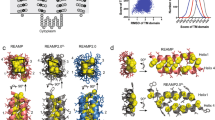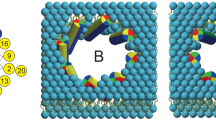Abstract
Specific helix–helix interactions inside lipid bilayers guide the folding and assembly of many integral membrane proteins and their complexes. We report here a pattern of 7 amino acids (LIxxGVxxGVxxT) which when introduced into several hydrophobic transmembrane α–helices promotes their specific dimerization. Dimerization is driven by interactions that are specific, dominated by the helix–helix interface, and involve no potentially ionizable groups. The motif may provide a useful tool for the functional analysis of such interactions in a variety of systems. Further, since this particular motif is rare, whilst specific helix association is not, many other such motifs may exist, which could permit sorting within complex membranes as well as guiding folding and oligomerization.
This is a preview of subscription content, access via your institution
Access options
Subscribe to this journal
Receive 12 print issues and online access
$189.00 per year
only $15.75 per issue
Buy this article
- Purchase on Springer Link
- Instant access to full article PDF
Prices may be subject to local taxes which are calculated during checkout
Similar content being viewed by others
References
Lemmon, M.A. & Engelman, D.M. Helix-helix interactions inside lipid bilayers. Curr. Op. struct. Biol. 2, 511–518 (1992).
Bormann, B.-J. & Engelman, D.M. Intramembrane helix association in oligomerization and transmembrane signalling. A. Rev. Biophys. biomolec. Struct. 21, 223–242 (1992).
Popot, J.-L. & Engelman, D.M. Membrane protein folding and oligomerization: The two-stage model. Biochemistry 29, 4031–1037 (1990).
Popot, J.-L. Integral membrane protein structure: Transmembrane α-helices as autonomous folding domains. Curr. Op. struct. Biol. 3, 532–540 (1993).
Lemmon, M.A. & Engelman, D.M. Specificity and promiscuity in membrane helix interactions. Quart. Rev. Biophys. (in the press, 1994).
Henderson, R. et al. Model for the structure of bacteriorhodopsin based on high-resolution electron cryo-microscopy. J. molec. Biol. 213, 899–929 (1990).
Popot, J.-L., Gerchman, S.E. & Engelman, D.M. Refolding of bacteriorhodopsin in lipid bilayers: A thermodynamically controlled two-stage process. J. molec. Biol. 198, 655–676 (1987).
Kahn, T.W. & Engelman, D.M. Bacteriorhodopsin can be refolded from two independently stable transmembrane helices and the complementary five-helix fragment. Biochemistry 31, 6144–6151 (1992).
Cosson, P., Lankford, S.P., Bonifacino, J.S. & Klausner, R.D. Membrane protein association by potential intramembrane charge pairs. Nature 351, 414–416 (1991).
Manolios, N., Bonifacino, J.S. & Klausner, R.D. Transmembrane helical interactions and the assembly of the T-cell receptor complex. Science 249, 274–277 (1990).
Kurosaki, T., Gander, I. & Ravetch, J.V. (1991). A subunit common to an IgG Fc receptor and the T-cell receptor mediates assembly through different interactions. Proc. natn. Acad. Sci. U.S.A. 88, 3837–3841 (1991).
Cosson, P. & Bonifacino, J.S. Role of transmembrane domain interactions in the assembly of class II MHC molecules. Science 258, 659–662 (1992).
Hendrickson, W.A. Modes of transduction. Curr. Biol. 2, 57–59 (1992).
Cao, H., Bangalore, L., Bormann, B.-J. & Stern, D.F. A subdomain in the transmembrane domain is necessary for p185neu* activation. EMBO J. 11, 923–932 (1992).
Weiner, D.B., Liu, J., Cohen, J.A., Williams, W.V. & Green, M.I. A point mutation in the neu oncogene mimics ligand induction of receptor aggregation. Nature 339, 230–231 (1989).
Schlessinger, J. & Ullrich, A. Growth factor signalling by receptor tyrosine kinases. Neuron 9, 383–391 (1992).
Nilsson, T., Slusarewicz, P., Hoe, M.H. & Warren, G. Kin recognition: A model for the retention of Golgi enzymes. FEBS Lett. 330, 1–4 (1993).
Weisz, O.A., Swift, A.M. & Machamer, C.E. Oligomerization of a membrane protein correlates with its retention in the Golgi complex. J. Cell Biol. 122, 1185–1196 (1993).
Smith, S. & Blobel, G. The first membrane spanning region of the lamin B receptor is sufficient for sorting to the inner nuclear membrane. J. Cell Biol. 120, 631–637 (1993).
Wozniak, R.W. & Blobel, G. The single transmembrane segment of gp210 is sufficient for sorting to the pore membrane domain of the nuclear envelope. J. Cell Biol. 119. 1441–1449 (1992).
Lemmon, M.A. et al. Glycophorin A dimerization is driven by specific interactions between transmembrane α-helices. J. biol. Chem. 267, 7683–7689 (1992).
Lemmon, M.A., Flanagan, J.M., Treutlein, H.R., Zhang, J. & Engelman, D.M. Sequence-specific dimerization of transmembrane 〈-helices. Biochemistry 31, 12719–12725 (1992).
Treutlein, H.R., Lemmon, M.A., Engelman, D.M. & Brünger, A.T. The glycophorin A transmembrane domain dimer: Sequence-specific propensity for a right-handed supercoil of helices. Biochemistry 31, 12726–12732 (1992).
Bormann, B.-J., Knowles, W.J. & Marchesi, V.T. Synthetic peptides mimic the assembly of transmembrane glycoproteins. J. biol. Chem. 264, 4033–4037 (1989).
Pakula, A.A. & Simon, M.I. Determination of transmembrane protein structure by disulfide cross-linking: The Escherichia coli Tar receptor. Proc natn. Acad. Sci. U.S.A. 89, 4144–4148 (1992).
Whitley, P., Nilsson, L. & von Heijne, G. Three-dimensional model for the membrane domain of Escherichia coli leader peptidase based on disulfide mapping. Biochemistry 32, 8534–8539 (1993).
Deber, C.M., Khan, A.R., Li, Z., Joensson, C., Glibowicka, M. & Wang, J. Val to Ala mutations selectively alter helix-helix packing in the transmembrane segment of phage M13 coat protein. Proc. natn. Acad. Sci. U.S.A. 90, 11648–11652 (1993).
Furthmayr, H. & Marchesi, V.T. Subunit structure of human erythrocyte glycophorin A. Biochemistry 15, 1137–1144 (1976).
Bargmann, C.I., Hung, M.-C. & Weinberg, R.A. Multiple independent activations of the neu oncogene by a point mutation altering the transmembrane domain of p185. Cell 45, 649–647 (1986).
Cao, H., Bangalore, L., Dompé, C., Bormann, B.-J. & Stern, D.F. An extra cysteine proximal to the transmembrane domain induces differential cross-linking of p185neu and p185neu*. J. biol. Chem. 267, 20489–20492 (1992).
Sternberg, M.J.E. & Gullick, W.J. A sequence motif in the transmembrane region of growth factor receptors with tyrosine kinase activity mediates dimerization. Protein Eng. 3, 245–248 (1990).
Wides, R.J., Zak, N.B. & Shilo, B.-Z. Enhancement of tyrosine kinase activity of the Drosophila epidermal growth factor homolog by alterations of the transmembrane domain. Eur. J. Biochem. 189, 637–645 (1990).
Frattali, A.L., Treadway, J.L. & Pessin, J.E. Evidence supporting a passive role for the insulin receptor transmembrane domain in insulin-dependent signal transduction. J. biol. Chem. 266, 9829–9834 (1991).
Longo, N., Shuster, R.C., Griffin, L.R., Langley, S.D. & Elsas, L.J. Activation of insulin receptor signaling by a single amino-acid substitution in the transmembrane domain. J. biol. Chem. 267, 12416–12419 (1992).
Yamada, K., Goncalves, E., Kahn, C.R. & Shoelson, S.E. Substitution of the insulin receptor transmembrane domain with the c-neu/erbB2 transmembrane domain constitutively activates the insulin receptor in vitro. J. biol. Chem. 267, 12452–12461 (1992).
Cheatham, B., Shoelson, S.E., Yamada, K., Goncalves, E. & Kahn, C.R. Substitution of the erbB-2 oncoprotein transmembrane domain activates the insulin receptor and modulates the action of insulin and insulin-receptor substrate 1. Proc. natn. Acad. Sci. U.S.A. 90, 7336–7340 (1993).
Carpenter, C.D. et al. Structural analysis of the transmembrane domain of the epidermal growth factor receptor. J. biol. Chem. 266, 5750–5755 (1991).
Kashles, O. et al. Ligand-induced stimulation of epidermal growth factor receptor mutants with altered transmembrane regions. Proc. natn. Acad. Sci. U.S.A. 85, 9567–9571 (1988).
Adair, B.D. An investigation into the effects of packing on the folding of integral membrane proteins. Ph.D. Thesis, Yale University, New Haven, CT, U.S.A. (1993).
Lee, A.W. & Nienhuis, A.W. Functional dissection of structural domains in the receptor for colony-stimulating factor-1. J. biol. Chem. 267, 16472–16483 (1992).
Devereux, J., Haeberli, P. & Smithies, O. A comprehensive set of sequence analysis programs for the VAX. Nucleic Acids Res. 12, 387–395 (1984).
Higuchi, R. Recombitant PCR. in PCR protocols, a guide to methods and applications (eds Innis, M.A. et al.) 177–183 (Academic Press, San Diego, 1990)
Author information
Authors and Affiliations
Rights and permissions
About this article
Cite this article
Lemmon, M., Treutlein, H., Adams, P. et al. A dimerization motif for transmembrane α–helices. Nat Struct Mol Biol 1, 157–163 (1994). https://doi.org/10.1038/nsb0394-157
Received:
Accepted:
Issue Date:
DOI: https://doi.org/10.1038/nsb0394-157
This article is cited by
-
Targeting promiscuous heterodimerization overcomes innate resistance to ERBB2 dimerization inhibitors in breast cancer
Breast Cancer Research (2019)
-
Atomic structure of the eukaryotic intramembrane RAS methyltransferase ICMT
Nature (2018)
-
Crystal structures of eukaryote glycosyltransferases reveal biologically relevant enzyme homooligomers
Cellular and Molecular Life Sciences (2018)
-
Effect of Membrane Composition on Receptor Association: Implications of Cancer Lipidomics on ErbB Receptors
The Journal of Membrane Biology (2018)
-
Molecular mechanism of synergy between the antimicrobial peptides PGLa and magainin 2
Scientific Reports (2017)



